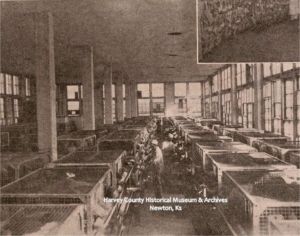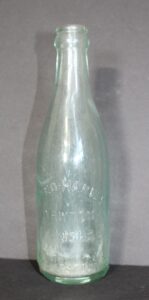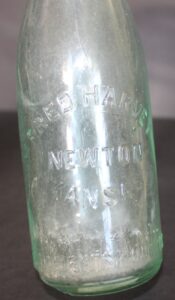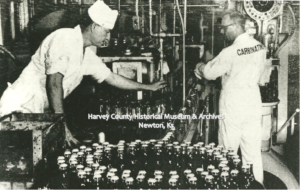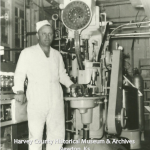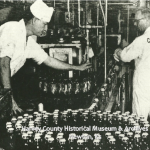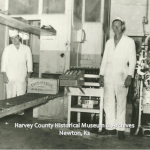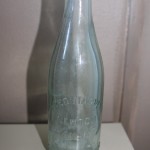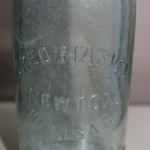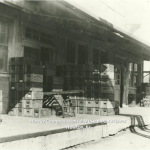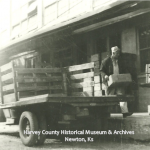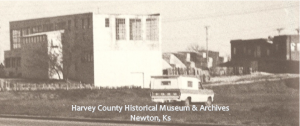May is Historic Preservation Month! Our focus this month is the stories of of the people behind the buildings. The demolition of the Fred Harvey Building on West First reminded me of my own family’s connection to the building – my great uncle was one of the many people from the Newton community that spent his working life in that building.
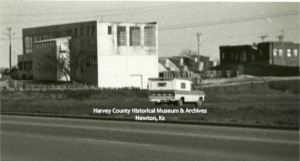
“Building to the left: Fred Harvey Produce and Carbonating Plant. Open area between the two buildings once contained the warehouse and refrigeration plant. Building to the right (south): Fred Harvey Dairy. – Mike Hurley.”
The Fred Harvey Building – North
Thanks to the meticulous research of L.M. ‘Mike’ Hurley, we know details that otherwise may have been lost about the operations of the Fred Harvey Farm. In 1905, Fred Harvey moved his operations from Kansas City, Mo. to the east bank of Sand Creek, Newton, Ks. The three story building, known as the north building, was built in 1918. The whole area was the Fred Harvey Farm, complete with a dairy, poultry, produce and processing plants, provided food for the Fred Harvey restaurants and dining on the Santa Fe cars.
Hurley described the layout of the north building. The third floor housed the poultry. The many windows allowed for ventilation and sunshine.
According to Hurley, the first floor was used only for killing the poultry with the only entrance on the west.
The second floor of the building was divided into two sections. The north section dealt with the processing of the poultry and divided into offices on the north and the south, where the poultry was dressed and chilled before packing.
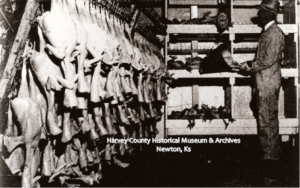
“Inside Fred Harvey Produce Building, Newton, Kansas. John Howard, buyer for Fred Harvey, inspecting and grading a rack of fowl in the chill room. Santa Fe Magazine. September 1954.”
Fred Harvey Coca-Cola
The south section of the second floor contained the carbonating plant, both the offices and the bottling, for the Fred Harvey brand of cola, root beer, club soda, ginger ale and fruit-flavored soft drinks. In 1914, the Coca-Cola Company allowed Fred Harvey to bottle Coca-Cola. Newton, Ks was on of the few places where Coca-Cola was bottled under a franchised issued by the company.
The Coke bottled at the Fred Harvey carbonating plant held high standards. Coca-Cola ran ran tests every six months to insure that standards were maintained. Everything produced at the Fred Harvey Farm was served exclusively at Fred Harvey dining facilities, news stands and aboard Santa Fe dining cars.
My great Uncle Ted Reimer worked for many years for Fred Harvey Enterprises in the carbonating plant. In 1954, he was the assistant manager, and pictured above on the right. Warren Boese is on the left. By the time, I got to know Uncle Ted, he was retired and all about fishing and teaching the great nieces and nephews to play pool. One thing was clear though, he had a sense of pride for his work for Fred Harvey Enterprises.
He was one of many who worked to insure that excellence was associated with the Fred Harvey name.
The Fred Harvey Farm was discontinued in 1960. Grover C. ‘Tex’ Owen was the last manager in charge of the farm.
Source
- Hurley, L.M. ‘Mike’. Newton, Kansas #1 Santa Fe Rail Hub 1871-1971. North Newton: Mennonite Press, 1985. Pages 137-139 specifically describe the Fred Harvey Farm. Information about the physical layout of the interior of the building is possible because of Mike’s research.



